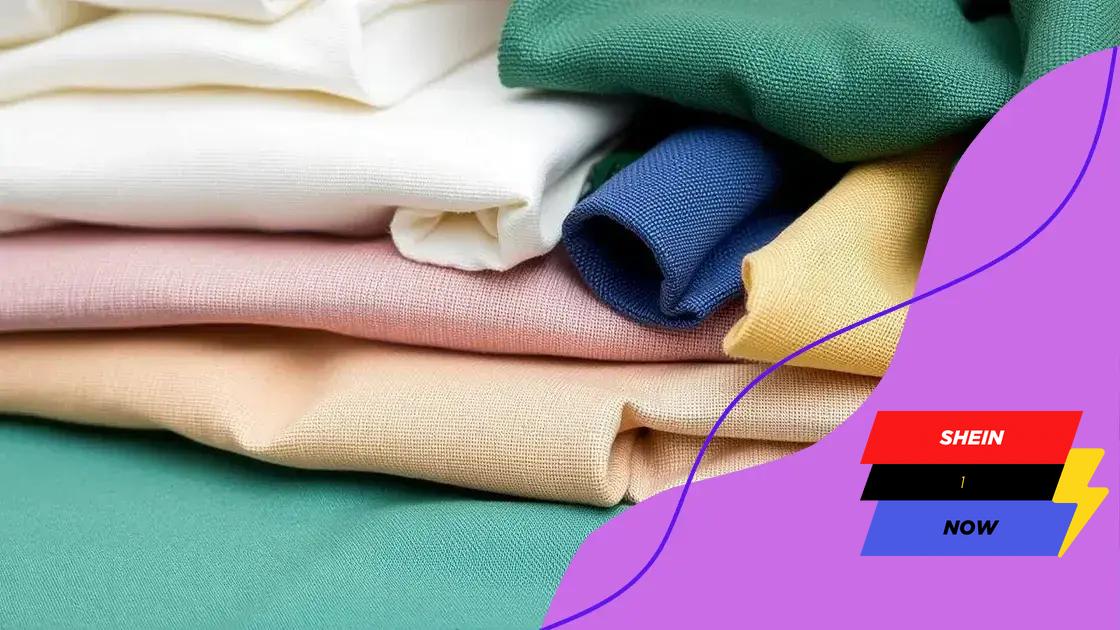Shein’s guides on sustainable fashion choices

Shein’s guides on sustainable fashion choices provide essential insights on selecting eco-friendly materials, supporting ethical brands, and building a sustainable wardrobe through mindful shopping practices.
Shein’s guides on sustainable fashion choices are a great way to rethink your shopping habits. Ever wondered how you can enjoy style while being eco-conscious? Let’s explore this together!
Understanding sustainable fashion
Sustainable fashion is more than just a trend; it’s a movement towards a more responsible way of dressing. Understanding sustainable fashion helps you make informed choices that benefit both your wardrobe and the planet.
What is Sustainable Fashion?
Sustainable fashion refers to clothing that is made with environmentally friendly practices. It focuses on reducing the carbon footprint and minimizing waste.
Key Principles of Sustainable Fashion
Some crucial principles of sustainable fashion include:
- Using eco-friendly materials
- Reducing water and energy consumption
- Promoting fair labor practices
- Encouraging recycling and upcycling
This approach not only helps the environment but also supports ethical practices in clothing production.
Every time you choose sustainable fashion, you contribute to a larger cause. By understanding the impact of fast fashion, you can see why making these choices is vital. Fast fashion often leads to mountains of waste and poor working conditions in factories. In contrast, sustainable fashion aims to create a more equitable and environmentally conscious industry.
When shopping for new clothes, consider looking for brands that prioritize sustainability. Check their materials and practices to ensure they align with your values. By doing so, you’re taking a step towards a healthier planet.
The impact of fast fashion
The impact of fast fashion is significant and far-reaching, affecting not only the environment but also society. Many people are unaware of the consequences that come from rapid and cheap clothing production.
Environmental Effects
Fast fashion contributes to pollution and waste. The production processes often release harmful chemicals into the air and water. Additionally, these garments are usually made from non-biodegradable materials, leading to mountains of textile waste in landfills.
- High water consumption during manufacturing
- Use of synthetic fibers that do not decompose
- Pesticides used in cotton farming
- Increased carbon emissions
These environmental issues highlight why it’s essential to think carefully about our clothing choices.
Socially, fast fashion often relies on poor labor practices. Workers in developing countries may face unsafe conditions and low pay. They might work long hours without the benefits that protect their rights. By understanding these realities, we can make more ethical choices when shopping.
It’s crucial to recognize how our spending habits influence these global practices. Choosing to support brands that prioritize sustainability and fair labor can drive change in the industry. You have the power to make a difference by opting for clothes made responsibly.
How to choose eco-friendly materials

Choosing eco-friendly materials is an essential step in building a sustainable wardrobe. By focusing on eco-friendly materials, you can reduce your impact on the environment and promote better practices in the fashion industry.
What Makes Materials Eco-Friendly?
Eco-friendly materials are sourced and processed in ways that are kind to the environment. They often involve less water use and minimal chemicals. Look for fabrics that follow these guidelines.
- Organic cotton: Grown without pesticides and synthetic fertilizers.
- Linen: Made from flax plants, it requires fewer resources.
- Bamboo: Rapidly renewable and biodegradable.
- Recycled materials: Such as recycled polyester made from plastic waste.
These options are not only better for the planet but often more durable too, leading to clothing that lasts longer.
When shopping for new clothes, always check the labels. Many brands are now openly sharing information about their materials and how their clothing is produced. This transparency helps you make informed decisions. Additionally, consider the production practices of the brands you support.
Incorporating eco-friendly materials into your wardrobe isn’t just beneficial for the environment; it also promotes a healthier lifestyle. The absence of harmful chemicals in organic fabrics means you’re wearing clothing that is safer for your skin. By making careful choices, you contribute to a more sustainable future and inspire others to do the same.
Tips for a sustainable wardrobe
Building a sustainable wardrobe is a rewarding journey that focuses on quality over quantity. By following some simple tips, you can create a collection of clothes that is both stylish and environmentally friendly.
1. Invest in Quality Pieces
Choosing high-quality clothing means your garments will last longer. Look for items that are well-made and versatile, so you can wear them for different occasions.
- Check the stitching and seams for durability.
- Choose classic styles that won’t go out of fashion.
- Select fabrics that are more durable, like wool or high-thread-count cotton.
This approach not only saves money in the long run but also reduces waste.
2. Embrace Secondhand Shopping
Thrift stores and online resale platforms are great places to find unique items. Embracing secondhand shopping is a fun way to discover new styles while helping the planet.
By buying used clothing, you keep perfectly good items out of landfills. Plus, you might find vintage pieces that add character to your wardrobe.
3. Organize and Declutter
Regularly reviewing your wardrobe helps keep it sustainable. By organizing your clothes, you can find items you forgot about and decide what you truly need.
Consider donating or recycling clothes that you no longer wear. This helps others while promoting a more mindful approach to consumption.
Creating a sustainable wardrobe is all about making choices that consider both your style and the environment. Choose consciously, shop wisely, and enjoy your unique looks while helping the planet.
Alternatives to fast fashion brands
Finding alternatives to fast fashion brands is a crucial step towards promoting sustainability in the fashion industry. There are many brands that focus on ethical practices and environmental responsibility.
1. Sustainable Clothing Brands
Look for companies that prioritize eco-friendly materials and fair labor practices. These brands often provide transparency about their production processes.
- Patagonia: Known for its commitment to sustainability and repairing old clothes.
- Eileen Fisher: Offers organic fabrics and has strong recycling programs.
- Everlane: Focuses on transparency in pricing and factories.
- Reformation: Combines style with sustainable practices, using eco-friendly materials.
By supporting these brands, you can help reduce the negative impacts of fast fashion.
2. Thrift and Vintage Shopping
Thrifting and shopping at vintage stores is not only sustainable but also a fun way to discover unique items. Each piece tells a story and adds character to your wardrobe.
Buying secondhand extends the life of clothing and reduces waste. Many online platforms also offer the chance to buy used clothes, making it easy to find good deals on quality items.
3. Renting Clothes
For special occasions, consider renting clothes instead of buying something new. This option allows you to wear something stylish without the commitment of ownership.
Many rental services curate collections of high-quality fashion for various events. This practice minimizes the demand for fast fashion while offering you access to beautiful outfits.
By exploring these alternatives to fast fashion brands, consumers can make smarter choices that contribute to a healthier planet while keeping their style fresh and unique.
With more awareness and effort, creating a sustainable wardrobe is entirely possible. By choosing eco-friendly materials and supporting ethical brands, you can make a positive impact on the environment. Remember to prioritize quality over quantity and consider secondhand options. Small changes in your shopping habits can lead to a healthier planet and a more stylish you.
FAQ – Frequently Asked Questions about Sustainable Fashion Choices
What is sustainable fashion?
Sustainable fashion refers to clothing that is made using environmentally friendly practices, minimizing waste and the use of harmful materials.
Why should I choose eco-friendly materials?
Choosing eco-friendly materials helps reduce your environmental impact, as these fabrics are often made with less water and fewer chemicals.
How can I find alternatives to fast fashion brands?
You can explore sustainable clothing brands, thrift and vintage shops, or consider renting clothes for special occasions.
What are some tips for maintaining a sustainable wardrobe?
Invest in quality pieces, shop secondhand, declutter regularly, and choose versatile items to create a timeless and sustainable wardrobe.





